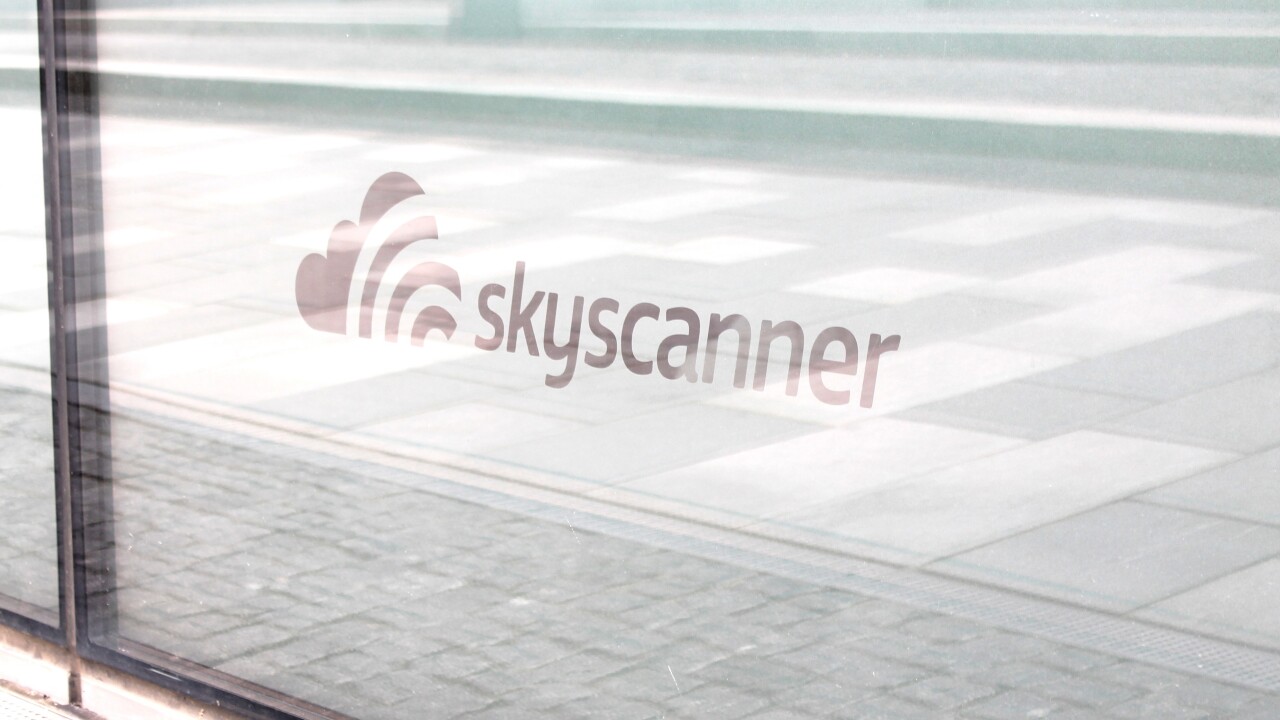
Emerging from the ashes of the first dotcom boom were a number of companies you all still know and love today. From the US, there’s Amazon and eBay, while over the pond in the UK there’s LastMinute.com, a travel-centric startup that faced flotations and multi-million dollar investments at a time when the ‘internet economy’ elsewhere was imploding.
These handful of success stories aside, in the years that followed the dotcom bust, one could’ve been excused for giving the Web-based startup scene a wide berth. The internet had become synonymous with half-baked ideas, opportunistic land-grabs and, with the benefit of hindsight, concepts that were too ahead of the technological capabilities of the time. Thankfully, some would-be entrepreneurs weren’t deterred from chasing the online dream.
In 2001, three UK-based IT professionals – Gareth Williams, Barry Smith and Bonamy Grimes – put their heads together to come up with a flight search engine called Skyscanner. Version one was developed and released in 2002, but it wasn’t until the following year when the first employee was taken on to help move things forward, ahead of its first physical office space opening in 2004.
Today, Skyscanner lays claim to being Europe’s largest travel search engine (by traffic), and the world’s second biggest – after the mighty Kayak.

Skyscanner is growing at breakneck speed, with revenues rising by 96 percent year-on-year in 2013 to $108.6 million. Traffic doubled too, reaching an average of 25 million unique visitors per month. While we’re talking numbers, Skyscanner also saw its mobile app downloads double last year, flying past the 30 million mark. It’s fair to say that 2013 was a pretty good year for the firm.
Much of this growth can be put down to its mobile strategy and focus on international markets. While it’s thought that around 80 percent of Kayak’s revenue stems from the US, Skyscanner says that only 20 percent of its income hails from domestic shores. Skyscanner has been busy localizing its search portal for a fair few years already, it has international hubs in Singapore, China, Miami and Barcelona, and it’s branching out into separate standalone mobile apps. It even has its own TV advert.
There’s little question that Skyscanner is a company on the up, and represents a major British success story. But perhaps the most notable facet of this story is that the company has chosen to base itself not in London, but in another capital city 400-odd miles up the road in Scotland.
Taking the high road
Scotland has a population of a little more than five million people – around three million less than the whole of London. Edinburgh, the capital, has around half-a-million inhabitants. Over the centuries, Scotland (and Edinburgh specifically) have produced and played host to more than its fair share of innovators – John Logie Baird developed the world’s first practical, publicly demonstrated television system, whilst Alexander Graham Bell is credited as inventing the first practical telephone. And let’s not forget about Alexander Fleming (penicillin), Robert Watson-Watt (RADAR), and John Shepherd-Barron (ATM). Charles Darwin even studied medicine at the University of Edinburgh.
In 2014, technology plays a big part in Scotland’s economy, but much of this relates to sectors such as renewable energy and banking. Indeed, Scotland is a major hub for financial institutions, with the Royal Bank of Scotland (RBS) – until relatively recently, the world’s biggest bank in terms of assets and market value – headquartered in Edinburgh. Savings and investments behemoth Standard Life also calls the Scottish capital home. But as far as successful, global Web-based consumer businesses are concerned, Skyscanner is Scotland’s poster child.
The Next Web paid a visit to meet CEO and co-founder Gareth Williams at Skyscanner’s impressive offices at Quartermile, a complex built at the former Edinburgh Royal Infirmary hospital site, about a 10-minute walk south of the city center.
Skyscanner HQ
Arriving at Skyscanner HQ, it’s obvious this is no fledgling startup. This is a company with ambition, confidence and perhaps just a hint of ‘The Valley’ coursing through its proverbial veins. A quick peek outside the third-floor window, however, at the ancient, world-famous Edinburgh Castle, serves as a stark reminder that this is a world away from the Californian startup glitz.
There’s evidently a core design theme too. The reception desk is set upon part of an old airplane wing…

…while video-conferencing rooms more than resemble airplanes too.


The open meeting booths certainly wouldn’t look out of place in a beach-side setting in French Polynesia, and the ‘huts’ are labeled accordingly. “Meet you at Bora Bora for a coffee and a catch-up on the latest quarterly report?” “You betcha!”, is how a typical Skyscanner conversation might go.

Elsewhere, the table tennis table can be swiftly transformed into a pool table with the deftest of slides too, and from what we hear it’s an activity taken quite seriously at Skyscanner HQ.

Meanwhile, what happens in the Yellow Room, stays in the Yellow Room. This is where people go to bash ideas around without fear of scorn.

In transit between the three floors, you can also take some time out to sketch something mirthsome, or pen some punchy prose. Markers are included, so you can leave your spray paint at your desk.

And if you’re growing a little tired of table tennis, graffiti and coffee in Bora Bora, you can always watch the server.

Skyscanner has been at its new abode since late 2012, and the move was made very much with the future in mind. At launch, the 300-person capacity space was barely half-full, but today it’s close to full. Fifty miles west of Edinburgh lies the capital’s more populous neighbor, Glasgow, which now serves as home to another 50 members of staff, a play made with one simple goal in mind.
By having a base in the west of Scotland, Skyscanner becomes just that little more appealing a place to work for those already based in and around Glasgow and the Central Belt, including graduates from Glasgow University or Strathclyde. That’s not to say, of course, that people aren’t prepared to relocate or commute, it’s just that by removing that obstacle, it instantly increases the recruitment opportunities. Elsewhere around the world Skyscanner employes around 60 people across Singapore, which serves the APAC market; Beijing, which exclusively serves China; and Miami, which naturally focuses on the Americas.
This seems like as good a time as any to delve a little deeper into the issue of recruiting techies in Scotland, especially when the lure of London lies a mere 4-hour train journey south of the border.
Tapping talent: The big smoke and the wee smoulder

So, what is life like for a company the size of Skyscanner in Edinburgh? Breezy, peaceful walks to work devoid of underground transport mayhem? Limitless supplies of Irn-Bru, and table tennis on tap? You bet. But things haven’t always been peaches and cream from a recruitment perspective.
“The downside is, you’re often hiring people that aren’t from the internet economy,” explains Williams. “Whereas in Silicon Valley, and to a lesser extent in London or Berlin, there is an established community of people who understand the internet economy, and how it applies to what they do, whether they’re a programmer, digital marketer, or whatever. So to an extent, we’ve had to build that culture ourselves.”
Indeed, one of the issues Skyscanner encountered early in its Edinburgh life was that much of the technical talent was from the dusty old financial sector, or straight out of university. That’s not necessarily a bad thing per se, but it does help if you have experienced, Web-focused minds from the get-go. Things are changing though.
“I think as Edinburgh has gotten more of a tech focus, we’re seeing things break down a little bit,” says Williams. “Plus, we’ve got one of the best computer science departments in Europe.”
Besides Skyscanner, Edinburgh University’s School of Informatics is the one place everyone mentions at some point when discussing the Edinburgh and Scottish tech scene. The school is one of the biggest computer research conglomerations in Europe, with hundreds of academic and research staff.
In the UK, a Research Assessment Exercise (RAE) is carried out by the higher education funding bodies which helps guides where public funds are distributed for research – Edinburgh came out trumps in the last two, in 2001 and 2008. And this is proving to be something of a boon for Skyscanner.
“We’re doing a lot of recruiting from the Informatics Department,” explains Williams. “We have quite a lot of graduates joining us this summer, I think we have around 40 interns coming in – mainly engineering, but some digital marketing interns too.”
It’s worth adding that this is not exclusively from Edinburgh University, with other big institutions such as the University of Glasgow and Heriot-Watt on Skyscanner’s radar too. But the university along the road does represent a significant chunk of its intake.
While it’s no doubt a good thing having a 21st century tech brand on your doorstep as a potential recruiter, doesn’t this bode poorly for the wider ecosystem, vis-à-vis ‘brain-drain’?
“I’ve heard that for sure,” says Williams, “but I don’t at all agree with it. We’ve got people who’ve done a few years with us that are joining other companies. And that’s exactly what’s needed. There are also people starting up companies that have worked at Skyscanner, and that’s how it should be. For as long as startups are recruiting from the finance sector, that is a bad thing…if all recruitment is coming from non-technology-focused sectors, that’s going to make every startup’s life harder.”
What we’re talking about here, of course, is an ecosystem. A buzzword and cliché perhaps, but it perfectly summarizes what could be going on. Just look at Nokia in Finland. Long before the mobile phone giant sold its prized assets to the mighty Microsoft, Nokia had been in steady decline, and this has had a marked effect on the Finnish economy and society.
Nokia was a global, household brand that employed tens-of-thousands of people from Finland, a country with a population of around five million. So when it started laying people off over the past four or five years, many of them have gone on to start their own companies. While there will no doubt be mixed feelings around the predicament Nokia currently finds itself, there is clear evidence that by having a concentration of talent, things can blossom.
While Skyscanner is on a completely different scale to Nokia, and it’s clearly not in decline, the same principles apply. When we last delved into the Scottish startup scene a few years back, we caught up with a handful of former Skyscanner employees who had left to do their own thing. Having a central magnet to attract developers, enhance skills and otherwise feed the local tech scene, can have a snowball effect over time.
“The more ‘internet economy’ someone has, the better,” says Williams. “And I think people graduating now are more naturally orientated that way, as opposed to people my age. Ten years ago, people were thinking more in terms of package software and working for an IT department, things that don’t apply in the internet economy.”
Skyscanner has been on a massive hiring spree over the past few years, more than tripling its head-count since 2011. And in the past year alone, 20 percent of of its new recruits have relocated to Edinburgh to take up posts, with more than a few shifting from London. Just a couple of weeks back, David Llewellyn was hired from Amazon in London to join Skyscanner as Head of Mobile Marketing for Europe. That’s a pretty big scoop right there.
This is indicative not only of the desire to live somewhere other than the ‘Big Smoke’ (London), but also of the status Skyscanner holds in the digital realm. The UK is badly in need of a second ‘hub’ of startup bustle, and while Edinburgh isn’t anywhere near claiming second position yet, there’s no real reason why it couldn’t stake a claim in the future.
A global perspective

One of the biggest marketing weapons in Skyscanner’s arsenal is its ‘world’s second biggest flight search engine’ status, after Kayak, which was acquired by Priceline back in 2012 for almost $2 billion. Then there’s Baidu-controlled Qunar from China which operates in a similar space, and which filed for a $125 million IPO in the US last year. All eyes must surely be on Skyscanner, either to go public or be snapped up by one of tech’s major heavyweights?
One major advantage Skyscanner has, as noted already, is its global footprint. While Qunar is largely focused on China, and Kayak drawing much of its attentions from the US, Skyscanner is pushing rapidly into the Earth’s farthest reaches.
Last year, the APAC region saw a 141 percent increase in monthly visitors for Skyscanner and, following the launch of an Americas base in Miami, it achieved a 119 percent year-on-year there. While percentages don’t tell the whole story and they can sometimes be misleading, it’s still indicative that this is a company in growth.
Back in 2012, China’s high-ranking search engine, Baidu, partnered with Skyscanner to power Baidu’s international flight search facility. This was a major deal for the Edinburgh company, but the China market is a notoriously hard nut to crack. “It has been [hard to crack], but we’re making traction,” says Williams. “We get more than a million uniques a month, but within the context of the size of the China travel market, it’s still early days.”
Looking further into the future, the Middle East and Africa are on Williams’ roadmap, but consolidation is still the name of the game for its existing markets, as is pushing out into new verticals. “There’s still a huge way to go in the markets that we’re currently in, and in geographic terms we’ve barely scratched the surface,” he says. “The move from being very much focused on flights, which is what most people know us for, to not only covering other products (e.g. hotels and car hire) but becoming a travel assistant – this will occupy us for quite some time.”
There’s a lot more to come from Skyscanner this year and beyond it seems, as it looks to “unify” the travel experience.
IPOs, acquisitions and Scottish independence
Relative to its size, Skyscanner has taken on very little VC funding. Silicon Valley firm Sequoia Capital completed a secondary round with Skyscanner last year, in a deal that valued Skyscanner at $800 million. But Scottish Equity Partners remains its biggest investor to date, with a $4 million input.
If you were to look at a list of near-billion-dollar value companies, pretty much all of them will have had more than $100 million in funding to get to that stage. “We got to that level, albeit over ten years, and with dramatically different money in,” says Williams. “Four million rather than hundreds of millions.”
While this places Skyscanner in a strong position in terms of retaining significant ‘internal’ control of its affairs, this perhaps played only a small part in its lack of funding to date. “Even if we’d wanted to, we could not have raised the sums of Silicon Valley,” continues Williams. “Because of where we are. And we’d have to make much greater progress before we start converging on the valuations that the internet economy produces. It’s only in recent years that we’ve had the ability to raise money should we want it – yet we’ve been able to do all that we’ve wanted to do, through organic means.”
In September last year, Skyscanner took its hotel-search service in-house when it acquired Barcelona-based travel company Fogg. And when you add all the other vital statistics together, to a casual observer, the company would seem ripe for either IPO-ing or being acquired. But Williams is very definite with his response to this prospect: “We don’t have any plans on that front,” he says. “It’s all a distraction from trying to fix a sector that is a long way from being solved.”
Perhaps a more pressing issue, not just for Skyscanner but the entire Scottish business community, is the subject of independence. In case you missed the memo, Scotland is holding a referendum in September this year to gauge whether or not it should remain a part of the United Kingdom. “It’s quite a common question,” remarks Williams. “But I’m completely staying out of that debate, if I got involved it would take up all my time. It’s a bit like death and taxes, we’ll deal with them as they hit us, there’s not much we can do about them.”
Skyscanner has become a lynchpin of the Scottish tech scene, a company flying the flag for a nation-within-a-nation globally.
“When we first started, we set out to find the biggest, Scottish-grown consumer website that’s out there and become bigger than it,” says Williams. “But I couldn’t find any. I mean, there was S1Jobs, but that was built by a corporate parent. I couldn’t find any others, because it was after the dotcom bust, and everything had imploded.”
13 years on, Skyscanner has become the company to emulate and overtake. A company for budding entrepreneurs and developers to look at and say, ‘If they can do it, I can do it’. When we’ll start seeing more online Scottish consumer tech companies gain traction globally remains to be seen, but there’s certainly a buzz in the air in Auld Reekie.
“It’s really great to see, there’s a lot more events on, and talks, it’s really good to see things building up in Edinburgh,” says Williams.
The Next Web will be taking a closer look at the Scottish startup scene over the coming weeks and months. Meanwhile, check out: CodeBase: A quest to kickstart Scotland’s startup ecosystem.
Get the TNW newsletter
Get the most important tech news in your inbox each week.




